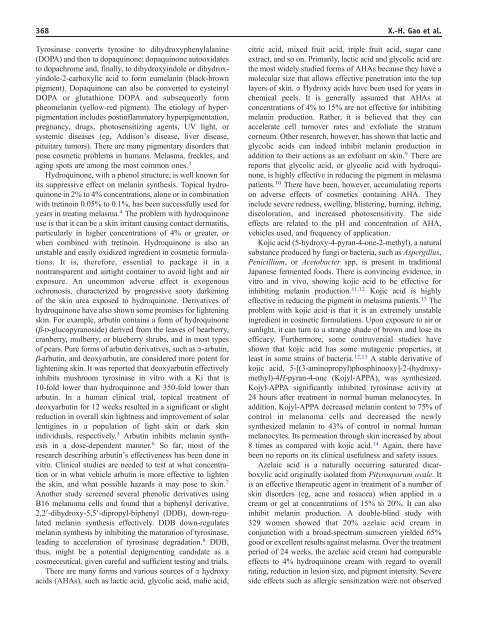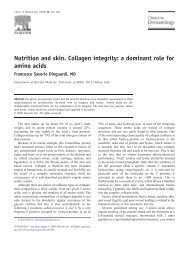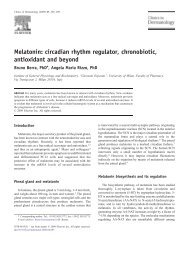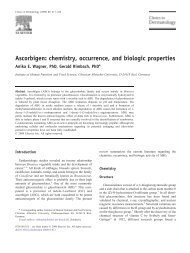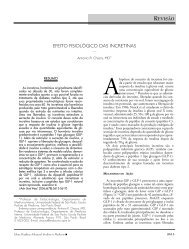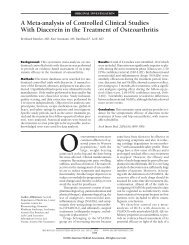Efficacy and safety of innovative cosmeceuticals
Efficacy and safety of innovative cosmeceuticals
Efficacy and safety of innovative cosmeceuticals
Create successful ePaper yourself
Turn your PDF publications into a flip-book with our unique Google optimized e-Paper software.
368 X.-H. Gao et al.<br />
Tyrosinase converts tyrosine to dihydroxyphenylalanine<br />
(DOPA) <strong>and</strong> then to dopaquinone; dopaquinone autooxidates<br />
to dopachrome <strong>and</strong>, finally, to dihydroxyindole or dihydroxyindole-2-carboxylic<br />
acid to form eumelanin (black-brown<br />
pigment). Dopaquinone can also be converted to cysteinyl<br />
DOPA or glutathione DOPA <strong>and</strong> subsequently form<br />
pheomelanin (yellow-red pigment). The etiology <strong>of</strong> hyperpigmentation<br />
includes postinflammatory hyperpigmentation,<br />
pregnancy, drugs, photosensitizing agents, UV light, or<br />
systemic diseases (eg, Addison's disease, liver disease,<br />
pituitary tumors). There are many pigmentary disorders that<br />
pose cosmetic problems in humans. Melasma, freckles, <strong>and</strong><br />
aging spots are among the most common ones. 3<br />
Hydroquinone, with a phenol structure, is well known for<br />
its suppressive effect on melanin synthesis. Topical hydroquinone<br />
in 2% to 4% concentrations, alone or in combination<br />
with tretinoin 0.05% to 0.1%, has been successfully used for<br />
years in treating melasma. 4 The problem with hydroquinone<br />
use is that it can be a skin irritant causing contact dermatitis,<br />
particularly in higher concentrations <strong>of</strong> 4% or greater, or<br />
when combined with tretinoin. Hydroquinone is also an<br />
unstable <strong>and</strong> easily oxidized ingredient in cosmetic formulations.<br />
It is, therefore, essential to package it in a<br />
nontransparent <strong>and</strong> airtight container to avoid light <strong>and</strong> air<br />
exposure. An uncommon adverse effect is exogenous<br />
ochronosis, characterized by progressive sooty darkening<br />
<strong>of</strong> the skin area exposed to hydroquinone. Derivatives <strong>of</strong><br />
hydroquinone have also shown some promises for lightening<br />
skin. For example, arbutin contains a form <strong>of</strong> hydroquinone<br />
(β-D-glucopyranoside) derived from the leaves <strong>of</strong> bearberry,<br />
cranberry, mulberry, or blueberry shrubs, <strong>and</strong> in most types<br />
<strong>of</strong> pears. Pure forms <strong>of</strong> arbutin derivatives, such as α-arbutin,<br />
β-arbutin, <strong>and</strong> deoxyarbutin, are considered more potent for<br />
lightening skin. It was reported that deoxyarbutin effectively<br />
inhibits mushroom tyrosinase in vitro with a Ki that is<br />
10-fold lower than hydroquinone <strong>and</strong> 350-fold lower than<br />
arbutin. In a human clinical trial, topical treatment <strong>of</strong><br />
deoxyarbutin for 12 weeks resulted in a significant or slight<br />
reduction in overall skin lightness <strong>and</strong> improvement <strong>of</strong> solar<br />
lentigines in a population <strong>of</strong> light skin or dark skin<br />
individuals, respectively. 5 Arbutin inhibits melanin synthesis<br />
in a dose-dependent manner. 6 So far, most <strong>of</strong> the<br />
research describing arbutin's effectiveness has been done in<br />
vitro. Clinical studies are needed to test at what concentration<br />
or in what vehicle arbutin is more effective to lighten<br />
the skin, <strong>and</strong> what possible hazards it may pose to skin. 7<br />
Another study screened several phenolic derivatives using<br />
B16 melanoma cells <strong>and</strong> found that a biphenyl derivative,<br />
2,2′-dihydroxy-5,5′-dipropyl-biphenyl (DDB), down-regulated<br />
melanin synthesis effectively. DDB down-regulates<br />
melanin synthesis by inhibiting the maturation <strong>of</strong> tyrosinase,<br />
leading to acceleration <strong>of</strong> tyrosinase degradation. 8 DDB,<br />
thus, might be a potential depigmenting c<strong>and</strong>idate as a<br />
cosmeceutical, given careful <strong>and</strong> sufficient testing <strong>and</strong> trials.<br />
There are many forms <strong>and</strong> various sources <strong>of</strong> α hydroxy<br />
acids (AHAs), such as lactic acid, glycolic acid, malic acid,<br />
citric acid, mixed fruit acid, triple fruit acid, sugar cane<br />
extract, <strong>and</strong> so on. Primarily, lactic acid <strong>and</strong> glycolic acid are<br />
the most widely studied forms <strong>of</strong> AHAs because they have a<br />
molecular size that allows effective penetration into the top<br />
layers <strong>of</strong> skin. α Hydroxy acids have been used for years in<br />
chemical peels. It is generally assumed that AHAs at<br />
concentrations <strong>of</strong> 4% to 15% are not effective for inhibiting<br />
melanin production. Rather, it is believed that they can<br />
accelerate cell turnover rates <strong>and</strong> exfoliate the stratum<br />
corneum. Other research, however, has shown that lactic <strong>and</strong><br />
glycolic acids can indeed inhibit melanin production in<br />
addition to their actions as an exfoliant on skin. 9 There are<br />
reports that glycolic acid, or glycolic acid with hydroquinone,<br />
is highly effective in reducing the pigment in melasma<br />
patients. 10 There have been, however, accumulating reports<br />
on adverse effects <strong>of</strong> cosmetics containing AHA. They<br />
include severe redness, swelling, blistering, burning, itching,<br />
discoloration, <strong>and</strong> increased photosensitivity. The side<br />
effects are related to the pH <strong>and</strong> concentration <strong>of</strong> AHA,<br />
vehicles used, <strong>and</strong> frequency <strong>of</strong> application.<br />
Kojic acid (5-hydroxy-4-pyran-4-one-2-methyl), a natural<br />
substance produced by fungi or bacteria, such as Aspergillus,<br />
Penicillium, or Acetobacter spp, is present in traditional<br />
Japanese fermented foods. There is convincing evidence, in<br />
vitro <strong>and</strong> in vivo, showing kojic acid to be effective for<br />
inhibiting melanin production. 11,12 Kojic acid is highly<br />
effective in reducing the pigment in melasma patients. 13 The<br />
problem with kojic acid is that it is an extremely unstable<br />
ingredient in cosmetic formulations. Upon exposure to air or<br />
sunlight, it can turn to a strange shade <strong>of</strong> brown <strong>and</strong> lose its<br />
efficacy. Furthermore, some controversial studies have<br />
shown that kojic acid has some mutagenic properties, at<br />
least in some strains <strong>of</strong> bacteria. 12,13 A stable derivative <strong>of</strong><br />
kojic acid, 5-[(3-aminopropyl)phosphinooxy]-2-(hydroxymethyl)-4H-pyran-4-one<br />
(Kojyl-APPA), was synthesized.<br />
Kojyl-APPA significantly inhibited tyrosinase activity at<br />
24 hours after treatment in normal human melanocytes. In<br />
addition, Kojyl-APPA decreased melanin content to 75% <strong>of</strong><br />
control in melanoma cells <strong>and</strong> decreased the newly<br />
synthesized melanin to 43% <strong>of</strong> control in normal human<br />
melanocytes. Its permeation through skin increased by about<br />
8 times as compared with kojic acid. 14 Again, there have<br />
been no reports on its clinical usefulness <strong>and</strong> <strong>safety</strong> issues.<br />
Azelaic acid is a naturally occurring saturated dicarboxylic<br />
acid originally isolated from Pityrosporum ovale. It<br />
is an effective therapeutic agent in treatment <strong>of</strong> a number <strong>of</strong><br />
skin disorders (eg, acne <strong>and</strong> rosacea) when applied in a<br />
cream or gel at concentrations <strong>of</strong> 15% to 20%. It can also<br />
inhibit melanin production. A double-blind study with<br />
329 women showed that 20% azelaic acid cream in<br />
conjunction with a broad-spectrum sunscreen yielded 65%<br />
good or excellent results against melasma. Over the treatment<br />
period <strong>of</strong> 24 weeks, the azelaic acid cream had comparable<br />
effects to 4% hydroquinone cream with regard to overall<br />
rating, reduction in lesion size, <strong>and</strong> pigment intensity. Severe<br />
side effects such as allergic sensitization were not observed


